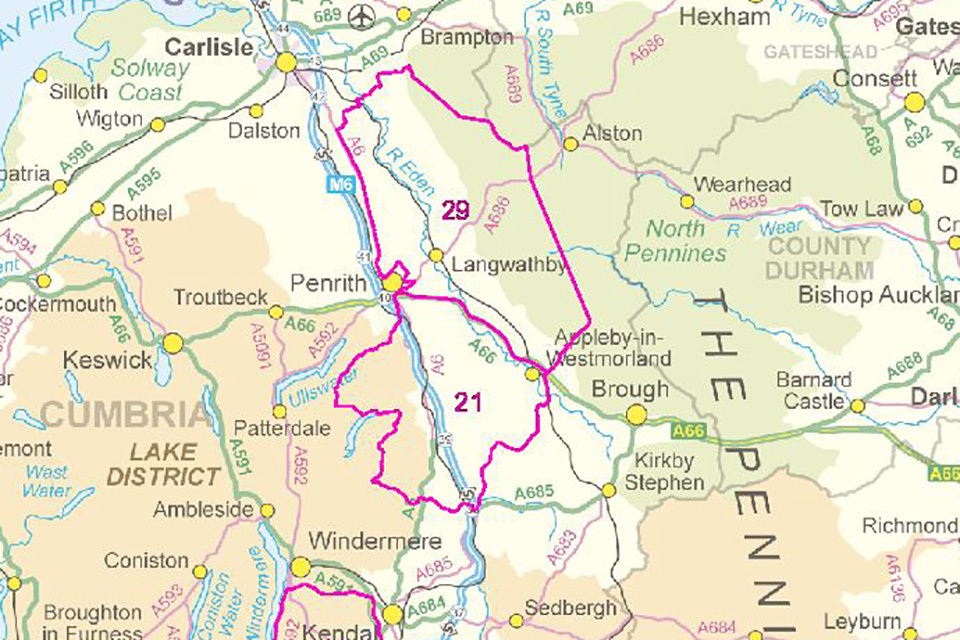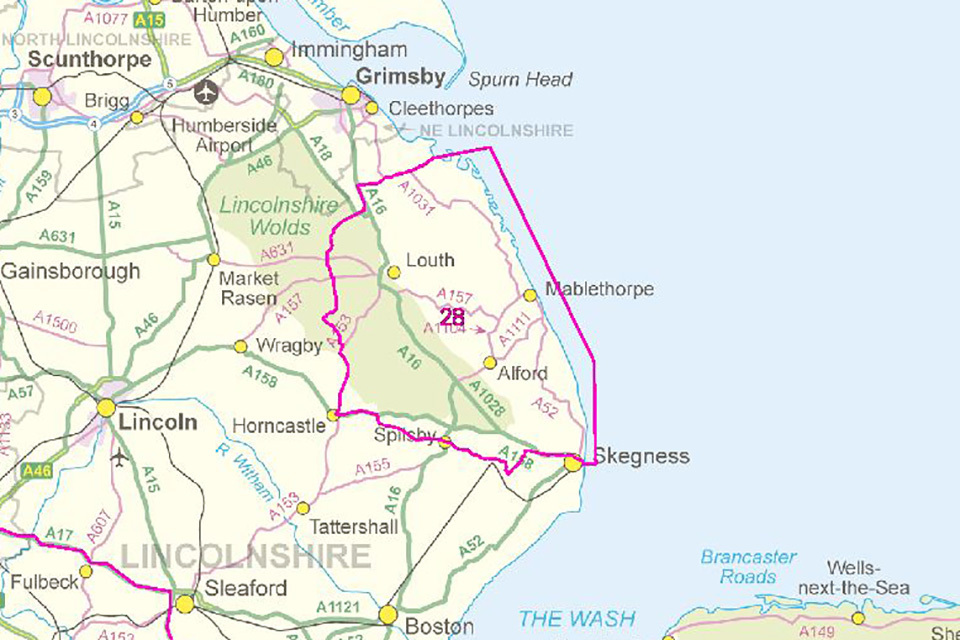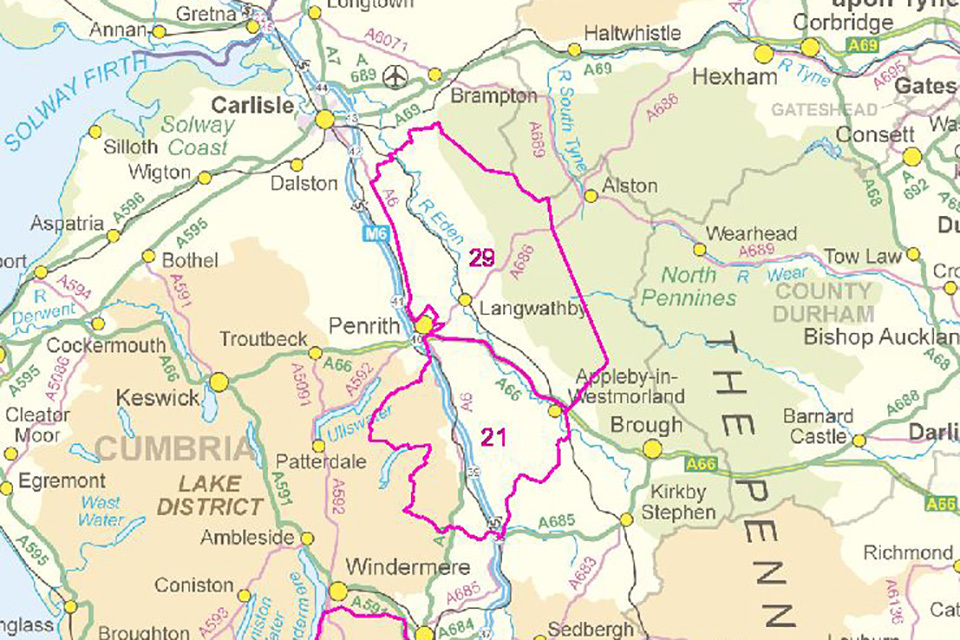April 2024: TB hotspots in the Low Risk Area of England
Updated 11 April 2025
Summary
Hotspots in the Low Risk Area of England are areas defined by the Animal and Plant Health Agency (APHA), where enhanced surveillance for bovine TB is carried out in both cattle and wildlife. The results of the ongoing surveillance of cattle and ‘found dead’ wildlife along with post-mortem examination and bacteriological culture of badger carcases removed during licensed culling operations are presented here and will inform future TB control measures in both badgers and cattle within the hotspots.
APHA is continuing to collect and test for TB in ‘found dead’ badgers and wild deer carcases within hotspots that are reported through the Defra Rural Service Helpline (03000 200 301).
Introduction
As part of the 2014 Strategy to achieve Officially Bovine Tuberculosis Free (OTF) status for England by 2038, 3 management areas were established: High Risk Area, Edge Area and Low Risk Area (LRA). Overall, the LRA has a very low and stable incidence of infected herds. The current strategy seeks to rapidly control infection when it arises through high sensitivity testing of affected herds and temporarily enhanced local TB surveillance through radial and hotspot testing, with the aim of preserving the favourable disease status of this area.
A hotspot is an area in the LRA of England with historically low TB incidence where enhanced TB control measures are carried out following detection of lesion- or culture-positive TB herd breakdowns of uncertain origin. These areas are defined and managed by APHA, who determine the most appropriate enhanced measures with the aim of eradication of disease in that area. Enhanced measures include, but are not limited to, more frequent cattle surveillance testing and a survey of TB in ‘found dead’ wildlife (badgers and deer).
Collection of ‘found dead’ wildlife carcases (badgers and deer) is conducted with the aim of establishing whether ‘M. bovis’ is present in the local wildlife population. This relies on the engagement and cooperation of local stakeholders reporting carcases via our web report form or to the Defra Rural Services Helpline (03000 200 301) for collection. Carcases will only be collected if they are intact, meaning not decomposed or too damaged, and they are in a safe place for collection.
Post-mortem examination (PME) is then conducted, with tissue samples taken for bacteriological culture so that if ‘M.bovis’ can be isolated, it undergoes Whole Genome Sequencing (WGS) analysis to establish if there are links to the local cattle breakdowns. It is important that as many carcases as possible are reported to inform epidemiological investigations.
At the time of writing there were 7 hotspot areas, 5 of which have infection identified in ‘found dead’ badger carcases. Hotspot 24 has now closed. Hotspots 26 and 27 are undergoing a closure review process, so are not included here.
Previously, areas have been referred to as ‘potential’ or ‘confirmed’ hotspots, depending on whether infection had been identified in wildlife populations. This has now changed. APHA is now managing hotspots in ‘stages’ covering cattle, and where relevant, wildlife. Further detail of how this is managed will be released in due course.
It is important that as many carcases as possible are reported to inform epidemiological investigation. APHA is continuing to test ‘found dead’ badgers and wild deer carcases within hotspots reported through the Defra Rural Services Helpline (03000 200 301).
Licensed badger disease control
Badger disease control has been licensed in the Low Risk Area of England (LRA) by Natural England since 2018 in hotspots where M.bovis-infected badgers have been found. The boundaries of the badger control intervention areas and the locations of infected badger carcases are not being released on security grounds. The badger control intervention areas are defined by APHA epidemiologists and ecologists and consist of:
- the minimum infected area (MIA)
- an outer area
Minimum infected area
This is based on the location of the infected badgers, associated farms and contiguous breakdown areas, plus a radius of the estimated average social group territory based on main sett distribution
Outer area
This is also based on estimated average badger social group territory size, surrounding the minimum infected area, to take into account the possibility that infection may have already spread in the badger population. The boundary is adjusted to adhere to natural barriers to badger movement as far as practical to minimise the risk of any possible perturbation effects .
As in previous years, APHA carried out TB surveillance using culled badger carcases to monitor the prevalence of ‘M.bovis’ infection and generating information for future operations in the area. Cage-trapped and controlled shot badger carcases removed from the cull areas underwent PME, with suitable tissue samples collected for culture of ‘M.bovis’ in the laboratory. Genotyping and WGS was then carried out on any isolates of the bacterium.
Hotspot 21
A hotspot area (HS21) was established in September 2016, due to a cluster of TB cattle herd breakdowns emerging from late 2014. It covers 360 kilometres squared (km sq) (Figure 1). Enhanced TB surveillance measures have been implemented in cattle and wildlife across the whole hotspot area, including the collection of ‘found dead’ badger and wild deer carcases.
The genotype of ‘M.bovis’ associated with HS21 (17:z, now WGS clade B6:23) had not previously been identified in cattle herds in Great Britain. Investigations concluded that disease is most likely to have been introduced by cattle imported from Northern Ireland. The novel genotype identified in both cattle and badgers in this area and the WGS analysis provided evidence that local spread of TB had likely occurred within cattle, then spilled over to badgers and eventually between both species.

Figure 1 shows Hotspot 21, located south of Penrith. It covers 360 km sq.
From identification of the index case in November 2014 to 31 December 2023, there have been 53 breakdowns associated with the hotspot, of which, 21 were OTF-Withdrawn (OTFW) and 32 were OTF-Suspended (OTFS). All herds are eligible to move from 6 monthly to annual whole herd testing, subject to certain criteria, from October 2023.
Collection of ‘found dead’ badgers and deer is ongoing in the area. From September 2016 to 1 March 2024, a total of 77 badger and 9 wild deer carcases have been submitted. There have been 3 M.bovis-positive badgers, all of which were identified in 2017, genetically related to the cattle cases. Not all reported carcases are collected and submitted for PME. Further detail is provided in the introduction.
Area 32 – Cumbria
Badger disease control operations were licensed and began within HS21 in September 2018, formally known as Area 32 – Cumbria. The sixth year of operations began in May 2023. To reflect the lack of infected badgers identified by PME across the area since 2020, vaccination is now carried out across the whole 218 km sq intervention area. Information on the decision making for badger disease control operations in Area 32 is available within the publication ‘Advice to Natural England on setting minimum and maximum numbers of badgers to be controlled in 2023’.
In 2023, 169 vaccinations were administered to badgers trapped by APHA staff. A total of 520 badger vaccinations have been given to date (100 in 2020, 111 in 2021, 140 in 2022).
Table 1. Prevalence in the sampled badgers in Area 32 – Cumbria
| Operational year | Carcases positive for M. bovis | Prevalence | |
|---|---|---|---|
| 2018 | 41 of 369 | 11.1% [95%CI 7.9, 14.3] | |
| 2019 | 3 of 313 | 1% [95%CI 0.0, 2.04] | |
| 2020 | 0 of 134 | 0% | |
| 2021 | 0 of 62 | 0% |
Note: The number of carcases tested may have been less than the total number removed due to operational reasons. The area where cull operations were conducted differed, based on the evidence available. More information can be found in previously published information.
Results from the ongoing enhanced surveillance of cattle and ‘found dead’ wildlife will be considered annually to inform future control measures in both badgers and cattle within HS21.
Hotspot 23
A hotspot area (HS23) was established in June 2018, following the disclosure of ‘M.bovis’ in a cattle herd in southwest Lincolnshire. Due to its proximity to, and shared genotype with, a cluster of OTFW breakdowns in northeast Leicestershire, this hotspot area straddles the LRA (Lincolnshire) and the Edge Area (Leicestershire and Nottingham). It is the largest of all the existing TB hotspots in the LRA, covering 1550 km sq (Figure 2). Enhanced TB surveillance measures have been implemented in cattle and wildlife across the whole hotspot area, including the collection of ‘found dead’ badger and wild deer carcases.
The WGS clade of ‘M.bovis’ associated with HS23 is B3:11, predominantly found in Cheshire, Derbyshire, Staffordshire, and northeast Shropshire. Investigations concluded that it had originally been introduced to the Edge Area portion of the hotspot via cattle movements from the Cheshire or Staffordshire area, and then subsequently introduced to the LRA.

Figure 2 shows Hotspot 23, around Grantham. It covers 1550 km sq.
From 1 January 2018 to 31 December 2023, there have been 147 breakdowns, of which 81 were OTFW and 66 were OTFS. 90% of cultured isolates belong to clade B3:11. All herds within the hotspot have been subject to annual whole herd testing from October 2020.
Collection of ‘found dead’ badgers and deer is ongoing in the area. From establishment of the hotspot to 1 March 2024, a total of 33 badger and 3 wild deer carcases have been submitted. There have been 3 badger carcases culture-positive for ‘M.bovis’, all identified pre-2020, one located in the Edge Area portion and 2 in the LRA portion, genetically related to the cattle cases. Not all reported carcases are collected and submitted for PME. Further detail is provided in the introduction.
Area 54 – Lincolnshire
Badger disease control operations were licensed and began within the LRA portion of HS23 in September 2020, formally known as Area 54 – Lincolnshire. The fourth year of operations began in September 2023. Information on the decision-making process for badger disease control operations in Area 54 is available within the publications Advice to Natural England on setting minimum and maximum numbers of badgers to be controlled in (year). Operations were deemed safe, effective and humane by the UK Chief Veterinary Officer (CVO). Further details of the outcomes of badger control operations have been published by Natural England (2024) Summary of badger control monitoring during 2023. In 2023, 89 badgers were removed from the badger disease control area.
Of those carcases, 4 (4.5%) were positive for ‘M.bovis’ across the whole area. Final results were still pending for 4 carcases at the time of compiling this report. Table 2 shows the change in prevalence within the sampled culled badger carcases over the 4 years of badger control operations in the area.
Table 2. Prevalence in the sampled badgers in Area 54 - Lincolnshire
| Operational year | Carcases positive for M. bovis | Prevalence | |
|---|---|---|---|
| 2020 | 34 of 139 | 24.5% [95%CI 17.4, 31.6] | |
| 2021 | 16 of 156 | 10.3% [95%CI 5.5, 15.1] | |
| 2022 | 6 of 80 | 7.5% [95%CI 1.7, 13.3] | |
| 2023 | 4 of 89 | 4.5% [95%CI 0.19, 8.8] |
The results presented here, alongside the ongoing enhanced surveillance of cattle and ‘found dead’ wildlife, will inform future control measures in both badgers and cattle within HS23.
Hotspot 28
A hotspot area (HS28) was established in July 2020 in response to the increase in OTFW breakdowns in the area. The boundary of this hotspot was adjusted in 2023 so that it now covers 780.4 km sq (Figure 3). Enhanced TB surveillance measures have been implemented in cattle and wildlife across the whole hotspot area, including the collection of ‘found dead’ badger and wild deer carcases.
The WGS clade of ‘M.bovis’ associated with HS23 is B3:11, predominantly found in Cheshire, Derbyshire, Staffordshire, and northeast Shropshire.

Figure 3 shows Hotspot 28, located around Louth. It covers 780.4 km sq.
Hotspot 29
A hotspot area (HS29) was established in January 2023 in response to the increase in OTFW breakdowns in the area over the previous years. It covers 510 km sq (Figure 4). Enhanced TB surveillance measures have been implemented in cattle and wildlife across the whole hotspot area, including the collection of ‘found dead’ badger and wild deer carcases.
The WGS clade of ‘M. bovis’ associated with HS23 is B3:11, predominantly found in Cheshire, Derbyshire, Staffordshire, and northeast Shropshire.

Figure 4 shows Hotspot 29, located northeast of Penrith. It covers 510 km sq.
From the index case in 2015 to 31 December 2023, there have been 34 breakdowns, of which 15 were OTFW and 19 were OTFS. All herds within the hotspot have been subject to 6 monthly whole herd testing from October 2023.
Collection of ‘found dead’ badgers and deer is ongoing in the area. From establishment of the hotspot to 1 March 2024, a total of 23 badger and 6 wild deer carcases have been submitted. One badger carcase was identified late 2023 as culture-positive for ‘M.bovis’ and genetically related to the cattle cases.
Hotspot 30
A hotspot area (HS30) was established early 2023 and covers 200 km sq (Figure 5). Enhanced TB surveillance measures have been implemented in cattle and wildlife across the whole hotspot area, including the collection of ‘found dead’ badger and wild deer carcases.
The WGS clade of ‘M.bovis’ associated with HS30 is B6:62.

Figure 5 shows Hotspot 30, located east of Aylesbury. It covers 200 km sq.
From establishing the hotspot in early 2023 to 31 December 2023, there have been 6 breakdowns, of which 2 were OTFW and 4 were OTFS. All herds within the hotspot have been subject to annual whole herd testing from October 2023.
Collection of ‘found dead’ badgers and deer is ongoing in the area. From establishment of the hotspot to 1 March 2024, a total of 6 badger carcases have been submitted. A single badger was collected during the Southern Edge RTA survey, run by APHA in collaboration with the University of Nottingham, in February 2022 from the portion of west Hertfordshire (LRA) extending into Buckinghamshire (Edge Area). ‘M.bovis’ was isolated and identified within WGS clade B6:62, linked to the cattle cases.
